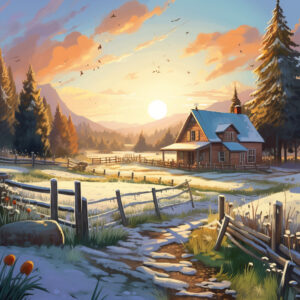See our first post in this series about fall and winter farming: Winter Crops for the Pacific Northwest: Thriving in the Chill
In western Washington, winter farming offers its own set of challenges and rewards. While we’ve previously explored the range of crops suitable for this chilly season, it’s essential to understand the protective measures you can take to safeguard these investments against freezing and other potential risks.
1. Understanding Frost and Its Effects
Frost occurs when water vapor condenses and freezes on surfaces, and it can damage or kill plants. Cells inside the plant can burst when water inside them freezes, leading to the plant’s demise.
2. Protective Measures against Freezing
Mulching: Applying a thick layer of organic mulch like straw or leaves can help retain soil moisture, suppress weeds, and insulate the soil, protecting roots from freezing temperatures.
Row Covers: Floating row covers made of lightweight fabric can be draped over plants, providing a few degrees of frost protection without smothering the plants.
Cold Frames: Essentially mini-greenhouses, cold frames are bottomless boxes with transparent tops. They trap heat and shield plants from cold winds, providing a microclimate that’s several degrees warmer than the surroundings.
Hoophouses and Low Tunnels: These are larger structures that cover garden beds, utilizing metal or PVC hoops draped with plastic or fabric. They provide a protected environment similar to cold frames but on a larger scale.
Water Before a Frost: Moist soil retains heat better than dry soil. Watering your plants the evening before a frost can help protect them, as the soil will release moisture overnight, raising the ambient temperature.
3. Other Winter Risks and Protection Strategies
Pest Control: Winter might reduce the number of pests, but some like slugs, snails, and certain rodents are still active. Regularly inspect plants, use slug bait, and consider setting traps for rodents.
Avoiding Waterlogged Soil: While watering is essential, overwatering, especially in our damp climate, can lead to root rot. Ensure proper drainage by raising beds or adding sand or gravel to the soil.
Wind Protection: High winds, especially cold ones, can desiccate plants and cause physical damage. Windbreaks, like hedges, fences, or even strategically placed bales of straw, can mitigate this.
Snow: While snow can insulate plants from extreme cold, heavy snow can break plant stems or collapse protective structures. After a snowfall, gently brush off excess snow from plants and structures.
4. Know When to Harvest
Some crops, like kale and Brussels sprouts, can tolerate and even benefit from a light frost. But for others, it’s essential to know when to harvest before potential damage. Keep an eye on weather forecasts and be prepared to harvest if severe freezes are predicted.
In conclusion, while winter farming in the Pacific Northwest has its challenges, with foresight and proactive measures, you can protect your crops and enjoy bountiful yields. Winter, in its silent beauty, can indeed be a season of growth. Happy and safe farming!


Get involved!
Comments